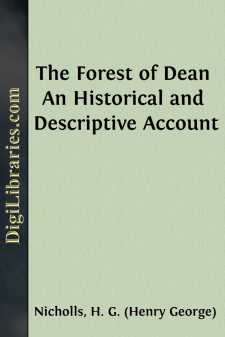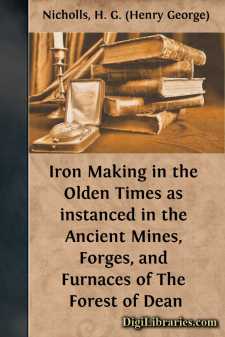Categories
- Antiques & Collectibles 13
- Architecture 36
- Art 48
- Bibles 22
- Biography & Autobiography 813
- Body, Mind & Spirit 142
- Business & Economics 28
- Children's Books 17
- Children's Fiction 14
- Computers 4
- Cooking 94
- Crafts & Hobbies 4
- Drama 346
- Education 46
- Family & Relationships 57
- Fiction 11829
- Games 19
- Gardening 17
- Health & Fitness 34
- History 1377
- House & Home 1
- Humor 147
- Juvenile Fiction 1873
- Juvenile Nonfiction 202
- Language Arts & Disciplines 88
- Law 16
- Literary Collections 686
- Literary Criticism 179
- Mathematics 13
- Medical 41
- Music 40
- Nature 179
- Non-Classifiable 1768
- Performing Arts 7
- Periodicals 1453
- Philosophy 64
- Photography 2
- Poetry 896
- Political Science 203
- Psychology 42
- Reference 154
- Religion 513
- Science 126
- Self-Help 84
- Social Science 81
- Sports & Recreation 34
- Study Aids 3
- Technology & Engineering 59
- Transportation 23
- Travel 463
- True Crime 29
The Forest of Dean An Historical and Descriptive Account
Categories:
Description:
Excerpt
CHAPTER I.
a.d. 1307–1612.
Origin of the name “Dean”?—The “Buck Stone,” and other Druidical remains—“The Scowles,” &c., and other ancient iron-mines, worked in the time of the Romans—Symmond’s Yat, and other military earthworks—Domesday Book, and investment of this Forest in the Crown—William I., and probable date of Free Miners’ Franchise—Castle of St. Briavel’s first built; Giraldus—Flaxley Abbey founded—King John at Flaxley and St. Briavel’s—The constables of St. Briavel’s and wardens of the Forest—Date of the ruins of St. Briavel’s Castle—Iron forges licensed by Henry III.—Perambulation of 1282, and first “Justice seat”—Seventy-two “itinerant forges” in the Forest—Date of Miners’ laws and privileges—Perambulation of 1302—Edward I., grants in the Forest—Newland Church founded—Free miners summoned to the sieges of Berwick, &c.—Edward II., grants in the Forest—Edward III., ditto—Richard II., ditto—Henry IV., ditto—Henry V., ditto—Henry VI., ditto—Severn barges stopped by Foresters—Edward IV., and retreat hither of the Earl Rivers and Sir J. Woodville—Edward VI. farmed the Forest to Sir A. Kingston—Design of the Spaniards to destroy the Forest—Papers from Sir J. Cæsar’s collection, viz. Sir J. Winter’s negotiations relative to the iron-works, &c.—Blast furnaces erected.
The district known as “the Forest of Dean” is situated within that part of Gloucestershire which is bounded by the rivers Severn and Wye. Its name is of doubtful origin. Was it so called from its proximity to the town of Mitcheldean, or Dean Magna, mentioned in Domesday Book, and which, agreeably to its name, is situated in a wooded valley, the word “Dean,” or “Dene,” being Saxon, and signifying a dale or den?—or do we accept the statement of Giraldus, and some other writers, that the Forest of Dean obtained its name from the Danes sheltering themselves in it, secured by its shades and thickets from the retaliation of the neighbouring people, whose country they had devastated?—Or, again, do we “fancy,” with Camden, that “by cutting off a syllable it is derived from Arden, which word the Gauls and Britons heretofore seemed to have used for a wood, since two very great forests, the one in Gallia Belgica, the other amongst us in Warwickshire, are called by one and the same name, Arden”? This latter suggestion Evelyn, in his ‘Sylva,’ accepts, in which he is supported by the fact that the name of “Dean” is first met with in William the Norman’s survey.
Probably the earliest trace of this locality being inhabited exists in the Druidical rocks which are found on the high lands on the Gloucestershire side of the Wye. The chief of them is “the Buck Stone,” so called perhaps from the deer which sheltered beneath it, or else from its fancied resemblance to that animal when viewed from certain distant spots. It is a huge mass of rock poised on the very crest of Staunton Hill, which being of a pyramidal form, and almost 1000 feet high, renders the stone on its summit visible in one direction as far as Ross, nine miles off. A careful examination of the structure of the rock, and particularly of the character of its base, will show that its position is natural. But that the Druids had appropriated it to sacrificial purposes, is evident from a rudely hollowed stone which lies adjacent. In shape “the Buck Stone” is almost flat on the top, and four-sided, the north-east side measuring sixteen feet five inches, the north seventeen feet, the south-west nine feet, and the south side twelve feet. The face of the rock on which it rests slopes considerably, and the bearing point is only two feet across. This part may be an unbroken neck of rock, but apparently the entire block has crushed down upon its base, as though, from having once formed the extremity of the portion of cliff near, it had fallen away, and had accidentally balanced itself in its present position. The texture of “the Buck Stone” is similar to that of the slab of rock on which it rests, commonly known as the old red sandstone conglomerate of quartz pebbles (a stratum of which extends through the whole district), exceedingly hard in most of its veins, but very perishable in others; and hence perhaps the form and origin of this singular object.
In addition to the above, there is a large mass of grit-stone, from nine to ten feet high, standing in a field on the north side of the road leading from Bream to St. Briavel’s, named “the Long Stone.” Another, called by the same name, and of similar character, occurs on the north-east side of the Staunton and Coleford road; but nothing remarkable is known of either of them, only their weather-worn appearance shows that they have been exposed to the action of the elements during many centuries.
Next in order of time to the above remains are the ancient Iron-mines, locally termed “Scowles,” which were undoubtedly worked when this island was occupied by the Romans. This appears certain from the coins, &c., which have been found deeply buried in the heaps of iron cinders derived from the workings of these mines. A highly interesting MS....



